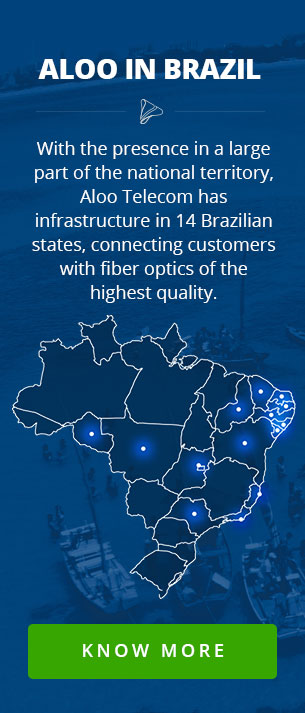Aloo Telecom launches fiber-optic network linking Fortaleza to Salvador

- Network connects to the Monet cable that connects Fortaleza to Miami
- Backbone serves major cities in the Northeast
- For 15 years the stretch connecting the two capitals has had no such investment
- Company continues its national expansion process
São Paulo, October 17, 2016 – Aloo Telecom, one of the largest telecommunications groups in the Northeast of Brazil, has put its new backbone (fiber optic network), connecting the cities of Fortaleza and Salvador, into operation. In an investment of R$ 50 million, the network is 2,100 km long and connects the submarine fiber optic cable Monet, which connects Miami to Fortaleza, to serve the cities of Mossoró, Natal, João Pessoa, Recife, Maceió, Aracaju, Alagoinhas and Camaçari.
With the latest technology and DWDM transmission equipment, the network starts operating with a capacity of up to 4.8 terabits per second (Tbps), but with a system ready to be expanded up to 9.6 Tbps in the next four years. “This backbone increases data transmission and internet speed in the Northeast of Brazil. The passage connecting the two capitals has nit has such investment for 15 years. The route serves all these states, starting with Salvador and interconnects the network that reaches Southeastern Brazil. In Fortaleza it interconnects with major submarine fiber optic cables that go to Miami,” says CEO, Felipe Cansanção.
Aloo Telecom was founded in Maceió and now has operations in almost all the states in the Northeast – Bahia, Sergipe, Alagoas, Pernambuco, Paraiba, Rio Grande do Norte and Ceará. Cansanção says the company’s strategy shadows the projected increase in Internet usage in Brazil and the Northeast region, which is expected to quadruple by 2020. “Today in Brazil an average of 5 Tbps is consumed. By 2020, it will be 20 Tbps,” says the businessman, who stresses that improved telephone and internet services will be provided by the infrastructure.
Expanding nationally, Aloo Telecom expects to get its portfolio of services into other regions of the country within two years. “The forecast is to roll out an additional 10,000 km of cables in São Paulo, Brasília, Mato Grosso, Rondônia, Minas Gerais and Espírito Santo,” adds Cansanção.





